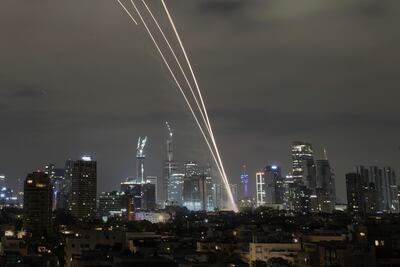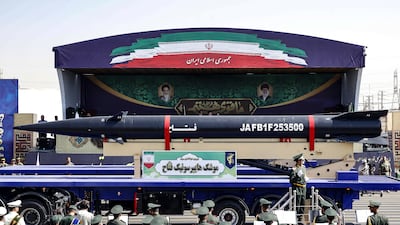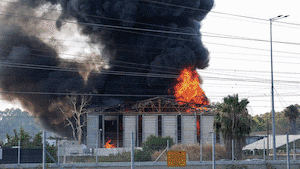One in 10 Iranian missiles are cutting through Israeli air defences with a pan-Middle East exchange of attacks now becoming a battle of resources, experts have told The National.
Iran is thought to be deploying its hypersonic Fatah-1 missiles, capable of flying at up to 18,600kph while manoeuvring in flight, making them difficult to intercept.
A battle of numbers is also developing, with the amount of relevant missiles Iran has, estimated at about 2,000, compared to the stockpile of Israel’s interceptors that has rapidly been used up in four days of bombardment.
Crucial to the outcome of this long-range war will be which side has the most missiles. If Israel’s world-leading Iron Dome, Arrow and the David’s Sling layered system runs out of interceptors, then its cities and industrial centres will be vulnerable to Iran’s missile fleet.
But if Israel manages to fend off the offensive – it is estimated Tehran has used 280 of its total stockpile – there will be no deterrent from further attacks.
Israel on Monday claimed it had destroyed a third of all Iranian missile launchers and now “controls the skies over Tehran”, although experts say its own missile interceptor stocks are “running low”.
Bleed through
Key to Iran’s successes in penetrating defences has been the Fatah-1 missile that entered service only two years ago. The medium-range missile travels on a fixed trajectory until a few hundred kilometres from its target when its movable nozzle is initiated, increasing speed threefold to up to Mach 15, allowing it to change course frequently.
That tactic is designed to throw off the calculations of Israel’s long-range radars that can track the threats, predicting impact points.
The ability to intercept a fast-moving missile high in the atmosphere is “phenomenally complex”, said Nick Brown, director of equipment intelligence at Janes, the defence intelligence company. These missiles operate in what is called exo-atmospheric flight, or outside Earth's atmosphere.
“The pure physics of making an exo-atmospheric or very high-speed interception within the atmosphere – basically making sure your interceptor is going to be in the right place at the right time – is phenomenally complex,” Mr Brown told The National.
The defenders could likely to fire two or three interceptors for every incoming missile, for which, with each Arrow-3 costing $3 million, there is a finite amount.
While Israel has good protection around its major cities, as well as military sites and key national infrastructure, it cannot protect the entire country, hence why some towns have been hit.
And even with the missile defence, Tel Aviv and the northern industrial city of Haifa have been struck. “If Iran can get enough missiles in the air simultaneously, some of them will likely bleed through,” Mr Brown said.
Reduced stocks
To win the missile war and reduce the negative political impact of a high civilian death toll, Israel will be heavily reliant on its sophisticated layered defensive system.
The key defence against high-speed missiles are the Arrow-2 and Arrow-3 interceptors – the latter is an exo-atmospheric system – that can take out threats along the arc of a ballistic trajectory.
Dr Sidharth Kaushal, an expert on missile technology at the Rusi think tank, said Israel has achieved a “high success rate of around 90 per cent” and the number of missiles “leaking through the Israeli defensive system is not especially high”.
“No system provides preclusive defence and if a system is saturated with enough missiles, some will get through."
But he warned the interceptors themselves, especially the Arrow-2 local coverage weapons, had unknown stockpiles and “the fact that the US has deployed a destroyer to abet the defence and is apparently considering further deployments would suggest that there is a meaningful risk of Israeli interceptor stockpiles running low”.
Poor accuracy
Most of Iran’s arsenal is based on the Shahab-3, a ballistic missile that once fired follows the same trajectory making it easier to shoot down.
But if the Shahab pierces defences – its accuracy is also quite poor – it carries a devastating 1,200kg warhead that will impact at about 8,600kmh.
Another more effective ballistic missile introduced in 2020 is the Haj Qasem, named after assassinated former Islamic Revolutionary Guard Corps commander Qassem Suleimani, that Iran claims can penetrate advanced air defences and strike targets with precision. It travels at Mach 12 (14,800kph), with a 500kg warhead.
Endurance test
But the Israel air force is pounding Iran’s supplies, especially as it appears to have achieved air superiority over the country, with many missiles and their launchers now being pre-emptively struck. “As such, the outcome of the test of endurance between the two sides is not yet certain,” Dr Kaushal said.
However, without those air strikes it might be possible for Iran to overwhelm the enemy air defence systems, either “by the sheer number of attacks, or by attacking from different directions”, said Dr Marion Messmer, an expert on arms control at Chatham House think tank.
“That’s why we've seen differing success rates in terms of the interception, especially with the hypersonic glide vehicles, when they remain manoeuvrable in flight. But the fact is that Israel has managed to intercept a huge amount of these various attacks.”
OPINIONS ON PALESTINE & ISRAEL
Milestones on the road to union
1970
October 26: Bahrain withdraws from a proposal to create a federation of nine with the seven Trucial States and Qatar.
December: Ahmed Al Suwaidi visits New York to discuss potential UN membership.
1971
March 1: Alex Douglas Hume, Conservative foreign secretary confirms that Britain will leave the Gulf and “strongly supports” the creation of a Union of Arab Emirates.
July 12: Historic meeting at which Sheikh Zayed and Sheikh Rashid make a binding agreement to create what will become the UAE.
July 18: It is announced that the UAE will be formed from six emirates, with a proposed constitution signed. RAK is not yet part of the agreement.
August 6: The fifth anniversary of Sheikh Zayed becoming Ruler of Abu Dhabi, with official celebrations deferred until later in the year.
August 15: Bahrain becomes independent.
September 3: Qatar becomes independent.
November 23-25: Meeting with Sheikh Zayed and Sheikh Rashid and senior British officials to fix December 2 as date of creation of the UAE.
November 29: At 5.30pm Iranian forces seize the Greater and Lesser Tunbs by force.
November 30: Despite a power sharing agreement, Tehran takes full control of Abu Musa.
November 31: UK officials visit all six participating Emirates to formally end the Trucial States treaties
December 2: 11am, Dubai. New Supreme Council formally elects Sheikh Zayed as President. Treaty of Friendship signed with the UK. 11.30am. Flag raising ceremony at Union House and Al Manhal Palace in Abu Dhabi witnessed by Sheikh Khalifa, then Crown Prince of Abu Dhabi.
December 6: Arab League formally admits the UAE. The first British Ambassador presents his credentials to Sheikh Zayed.
December 9: UAE joins the United Nations.
Founders: Abdulmajeed Alsukhan, Turki Bin Zarah and Abdulmohsen Albabtain.
Based: Riyadh
Offices: UAE, Vietnam and Germany
Founded: September, 2020
Number of employees: 70
Sector: FinTech, online payment solutions
Funding to date: $116m in two funding rounds
Investors: Checkout.com, Impact46, Vision Ventures, Wealth Well, Seedra, Khwarizmi, Hala Ventures, Nama Ventures and family offices
Book%20Details
%3Cp%3E%3Cem%3EThree%20Centuries%20of%20Travel%20Writing%20by%20Muslim%20Women%3C%2Fem%3E%3Cbr%3E%3Cstrong%3EEditors%3A%20%3C%2Fstrong%3ESiobhan%20Lambert-Hurley%2C%20Daniel%20Majchrowicz%2C%20Sunil%20Sharma%3Cbr%3E%3Cstrong%3EPublisher%3A%20%3C%2Fstrong%3EIndiana%20University%20Press%3B%20532%20pages%3Cbr%3E%3C%2Fp%3E%0A
Who was Alfred Nobel?
The Nobel Prize was created by wealthy Swedish chemist and entrepreneur Alfred Nobel.
- In his will he dictated that the bulk of his estate should be used to fund "prizes to those who, during the preceding year, have conferred the greatest benefit to humankind".
- Nobel is best known as the inventor of dynamite, but also wrote poetry and drama and could speak Russian, French, English and German by the age of 17. The five original prize categories reflect the interests closest to his heart.
- Nobel died in 1896 but it took until 1901, following a legal battle over his will, before the first prizes were awarded.
Our family matters legal consultant
Name: Hassan Mohsen Elhais
Position: legal consultant with Al Rowaad Advocates and Legal Consultants.
57%20Seconds
%3Cp%3E%3Cstrong%3EDirector%3A%3C%2Fstrong%3E%20Rusty%20Cundieff%0D%3Cbr%3E%3Cstrong%3EStars%3A%20%3C%2Fstrong%3EJosh%20Hutcherson%2C%20Morgan%20Freeman%2C%20Greg%20Germann%2C%20Lovie%20Simone%0D%3Cbr%3E%3Cstrong%3ERating%3A%20%3C%2Fstrong%3E2%2F5%0D%3Cbr%3E%0D%3Cbr%3E%3C%2Fp%3E%0A
MATCH INFO
First Test at Barbados
West Indies won by 381 runs
Second Test at Antigua
West Indies won by 10 wickets
Third Test at St Lucia
February 9-13
UAE currency: the story behind the money in your pockets
Tips for taking the metro
- set out well ahead of time
- make sure you have at least Dh15 on you Nol card, as there could be big queues for top-up machines
- enter the right cabin. The train may be too busy to move between carriages once you're on
- don't carry too much luggage and tuck it under a seat to make room for fellow passengers
Wicked: For Good
Director: Jon M Chu
Starring: Ariana Grande, Cynthia Erivo, Jonathan Bailey, Jeff Goldblum, Michelle Yeoh, Ethan Slater
Rating: 4/5
Director: Laxman Utekar
Cast: Vicky Kaushal, Akshaye Khanna, Diana Penty, Vineet Kumar Singh, Rashmika Mandanna
Rating: 1/5
COMPANY PROFILE
Name: Kumulus Water
Started: 2021
Founders: Iheb Triki and Mohamed Ali Abid
Based: Tunisia
Sector: Water technology
Number of staff: 22
Investment raised: $4 million
Company%20profile
%3Cp%3E%3Cstrong%3EName%3A%3C%2Fstrong%3E%20Homie%20Portal%20LLC%3C%2Fp%3E%0A%3Cp%3E%3Cstrong%3EStarted%3A%3C%2Fstrong%3E%20End%20of%202021%C2%A0%3C%2Fp%3E%0A%3Cp%3E%3Cstrong%3EFounder%3A%20%3C%2Fstrong%3EAbdulla%20Al%20Kamda%C2%A0%3C%2Fp%3E%0A%3Cp%3E%3Cstrong%3EBased%3A%3C%2Fstrong%3E%20Dubai%3C%2Fp%3E%0A%3Cp%3E%3Cstrong%3ESector%3A%3C%2Fstrong%3E%20FinTech%C2%A0%3C%2Fp%3E%0A%3Cp%3E%3Cstrong%3EInitial%20investment%3A%3C%2Fstrong%3E%20Undisclosed%C2%A0%3C%2Fp%3E%0A%3Cp%3E%3Cstrong%3ECurrent%20number%20of%20staff%3A%3C%2Fstrong%3E%2014%C2%A0%3C%2Fp%3E%0A%3Cp%3E%3Cstrong%3EInvestment%20stage%3A%20%3C%2Fstrong%3ELaunch%C2%A0%3C%2Fp%3E%0A%3Cp%3E%3Cstrong%3EInvestors%3A%3C%2Fstrong%3E%20Self-funded%3C%2Fp%3E%0A
Timeline
2012-2015
The company offers payments/bribes to win key contracts in the Middle East
May 2017
The UK SFO officially opens investigation into Petrofac’s use of agents, corruption, and potential bribery to secure contracts
September 2021
Petrofac pleads guilty to seven counts of failing to prevent bribery under the UK Bribery Act
October 2021
Court fines Petrofac £77 million for bribery. Former executive receives a two-year suspended sentence
December 2024
Petrofac enters into comprehensive restructuring to strengthen the financial position of the group
May 2025
The High Court of England and Wales approves the company’s restructuring plan
July 2025
The Court of Appeal issues a judgment challenging parts of the restructuring plan
August 2025
Petrofac issues a business update to execute the restructuring and confirms it will appeal the Court of Appeal decision
October 2025
Petrofac loses a major TenneT offshore wind contract worth €13 billion. Holding company files for administration in the UK. Petrofac delisted from the London Stock Exchange
November 2025
180 Petrofac employees laid off in the UAE







